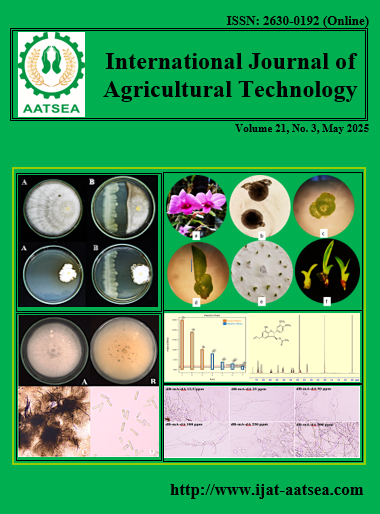NaCl floatation method on physicochemical quality of Kaew Kamin mango during harvesting indices.
Main Article Content
Abstract
It was found that harvesting stages were significantly affected the fruit quality. Fruit weight of Kaew Kamin mango followed a sigmoidal pattern. NaCl floatation method was not appropriated for determination of harvesting indices (HI) but could be used in cases where indicator for the quality assessment of fruits. SG2 group showed good properties for unripe mangoes, considering as physiological mature. The highest number of fruits in SG2 group (more than 80%) was harvested at 98 DAFB and considered as optimum physiological maturity stage for harvesting Kaew Kamin mango. Conclusively NaCl floatation method could be separated the Kaew Kamin mango quality grading in commercial and physiological maturity period.
Article Details

This work is licensed under a Creative Commons Attribution-NonCommercial-NoDerivatives 4.0 International License.
References
AOAC (1995). Official methods of analysis. 16th Edition, The Association of Official Analysis Chemists, Washington, 1141 p.
AOAC (2000). Official methods of analysis. 17th Edition, The Association of Official Analytical Chemists, Maryland, USA.
Fuchs, Y., Pesis, E. and Zauberman, G. (1980). Changes in amylase activity, starch and sugars contents in mango fruit pulp. Scientia Horticulturae, 13:155-160.
Hong, J. H. and Gross, K. C. (1998). Surface sterilization of whole tomato fruit with sodium hypochlorite influences subsequent postharvest behavior of fresh-cut slices. Journal of Postharvest Biology, 13:51-58.
Kanda, W., Uthaibutra, J. and Kampoun, W. (2008). Effect of maturity stages and low temperature storage on postharvest quality of ‘Mahajanaka’ mango fruit for export. (Research Report). Chiang Mai University, Chaing Mai, Thailand.
Ketsa, S., Phakawatmongkol, W. and Subhadrabhandhu, S. (1999). Peel enzymatic activity and colour changes in ripening mango fruit. Journal of Plant Physiology, 154:363-366.
Ketsa, S., Rattanamalee, S. and Babprasert, C. (1991). Growth, development, biochemical changes and harvesting index of mango (Mangifera indica L.) cv. Tongdum. Kasetsart Journal (Natural Science), 25:391-399.
Lueangprasert, K., Pattanayaiying, R., Chuajedton, A., Choojit, S. and Sealim, K. (2023). Quality evaluation of Kaew Kamin mango with specific gravity at commercial maturity stage. RMUTSB Academic Journal, 11:211-222.
Maldonado, F., Yuri, J. A., Neira, A. and Razmilic, I. (2022). Total phenolics, quercetin glycosides and antioxidant activity in organic and conventional orchards in three apple cultivars during fruit growth. Spanish Journal of Agricultural Research, 20:1-10.
Mattoo, A. K., Murata, T., Pantastico, Er. B., Chachin, K., Ogata, K. and Phan, C. T. (1975). Chemical changes during ripening and senescence. In: Pantastico ErB ed. Posthavest physiology, handling and utilization of tropical and subtorpical fruits and vegetables, AVI Publishing company, Westport, Connecticut, pp.103-127.
More, S. and Rao, T. R. (2019). Elicitor-mediated sanitization in combination with edible coatings improve post harvest shelf life and antioxidant potential of mango fruit. Environment Experimental Biology, 17:107-114.
Mun’im, A., Negishi, O. and Ozawa, T. (2003). Antioxidant compounds from Crotalaria sessiliflora. Bioscience, Biotechnology and Biochemistry, 67:410-414.
Roe, B. and Bruemmer, J. H. (1981). Changes in pectic substances and enzymes during ripening and storage of “Keitt” mangos. Journal of Food Science, 46:186-189.
Sarma, B., Das, K. and Bora, S. S. (2020). Physiology of fruit development. International Journal of Current Microbiology and Applied Sciences, 9:504-521.
Selvaraj, Y. and Kumar, R. (1989). Studies on fruit softening enzymes and polyphenol oxidase activity in ripening mango (Mangifera indica L.) fruit. Journal of Food Science and Technology-Mysore, 57:690-692.
Singleton, V. L. and Rossi, J. R. (1965). Colorimetry of total phenolics with phosphomolybdic-phosphotungstic acid reagents. American Journal of Enology and Viticulture, 16:144-57.
Siripattanakul, W., Tuntratian, S. and Charittsean, T. (2002). Maturity and aging condition of mango variety Sam-pee for mango juice production. Proceeding of the 40th Kasetsart University Annual Conference: Plants, Agricultural Extension and Communication, Ago-Industry, Kasetsart University, Bangkok, 413-420.
Sombatpraiwan, S., Tipyavimol, T. and Treeamnul, K. (2012). Postharvest changes in quality characteristics of Nam Dokmai mango (Mangifera indica L.). The 13th TSAE National Conference. Chiamg Mai, 518-525.
Spencer, J. L., Morris, M. P. and Kennard, W. C. (1955). Vitamin c concentration in developing and mature fruits of mango (Mangifera indica L.). Plant Physiology, 29:79-80.
Steven, N. (1980). Tropical and Subtropical Fruits. AVI Publishing, Inc. Westport, Connecticut.
Subramanyam, H., Gouri, S. and Krishnamurthy, S. (1976). Ripening behaviour of mango fruits graded on specific gravity basis. Journal of Food Science and Technology, 13:84-86.
Tucker, G. A. (1993). Introduction. In: Seymour GB, Taylor JE and Tucker GA eds. Biochemistry of fruit ripening, Springer Netherlands, pp.1-51.
Ueda, M., Sasaki, K., Utsunomiya, N., Inaba, K. and Shimabayashi, Y. (2000). Changes in physical and chemical properties during maturation of mango fFruit (Mangifera indica L. ‘Irwin’) cultured in a plastic greenhouse. Food Science and Technology Research, 6:299-305.
Wojdylo, A. and Oszmiański, J. (2020). Antioxidant activity modulated by polyphenol contents in apple and leaves during fruit development and ripening. Antioxidants, 9:1-12.


